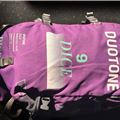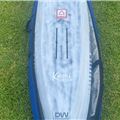6:54 PM Thu 27 Oct 2011 GMT

|
|
'Sailing in the Southern Ocean - Clipper Round the World Race'
Clipper Ventures
|
Clipper Round the World Yacht Race 2011-12 crew member Lisa Blair representing Queensland on Gold Coast Australia sends her thoughts on the race:
'The good ship Gold Coast Australia has now sailed its third week in the fourth race of the Clipper Round the World Yacht Race of what is proving to be a very tactical race from Cape Town to Geraldton in Western Australia. Leading the fleet across the Indian Ocean and down to the frigid temperatures of the Southern Oceans where we continue to make ground to the east the crew experience a verity of challenges in different weather conditions.
After experiencing the fury of the Southern Ocean with winds of more than 60 knots of wind, the crew was left with large swells on day 12 offering up some challenging helming conditions. We were regularly surfing waves at 15, 16 and even 18 knots of speed as we witness the large swell that this ocean is known for. Waves the size of houses, dark gray in colour, frothing white at the top as they tower above you.
At one stage I was on the helm simply waiting for the next watch to come on deck at hand over time when out of nowhere the stern of the boat is picked up, I was now looking straight down the face of this huge wave as the entire 68 foot boat that weighs 38 tonnes is lifted like nothing. I can see the bow tilted down to an incredible angle with a few meters of water to spare at the end until the trough. My first reaction was to think pitch polling, a disastrous sailing manoeuvre where the boat's bow can get buried in the wave in front and get flipped bow to stern causing irreparable damage to the vessel often, taking the mast.
In order to avoid this as we accelerated down this monster wave I turned the helm hard to port in an effort to take the boat along the face of the wave and not just straight down. We continued to accelerate until there was so much spray around that I could not see where I was helming, it was just a sea of white foam getting thrown up from both port and starboard rails well above my head. I shouted for the deck crew to hold on as the next danger became apparent.
If I helmed too high we could get knocked flat on our side by the incredible force of this wave, so once again I adjusted my course and turned the helm to starboard to help guide the boat along the face of the wave. Everything was vibrating and shaking with the force of it and the g-forces that we created as I surfed the biggest wave of my life.
Laughing with adrenalin, fear and excitement we surfed and surfed. There were squeals of excitement and fear from the port side as two of the crew were buried in the spray. Down below Skipper Richard Hewson was giving the daily 'Happy Hour' brief to the rest of the crew and was watching the boat speed on the instruments with crew member Dan Oliver. Once it was over and our boat speed returned to normal speeds or at least normal for the Southern Ocean, Dan popped his head out of the companionway and said that my max boat speed was 22.9 knots during the surf. I really wish we had managed to get the speed over ground as the log is continually under reading. The end result was that we surfed down a wave with a face of 70 feet, absolutely wonderful.
On day 14 the crew on Gold Coast Australia experienced yet more challenges such as another snapped preventer, riding turns on the Main Sheet quickly followed by two crash gybes and the working Yankee sheet breaking off so that the Yankee flogged out of control until the crew could retrieve it, resulting in several damaged hanks. By dawn the next day we had recovered from the evenings dramas were still holding first place when the morning skeds came through.
Rich has been monitoring a large High Pressure system that was tracking over from the west to the east travelling at speeds of over 30 knots. Rich made the call to Gybe on day 16 and travel south down to Latitude 48 degrees South in an effort to skirt the bottom of the pressure system that stretches over 700 nautical miles long. This resulted in the coldest air temperatures of the race yet bringing us 300 nautical miles closer to Antarctica than Australia.
With the cold temperatures of the south, those crew members who have not come fully prepared with warm enough layers have now resorted to improvisation with some very interesting techniques. Tim Burgess has now been dubbed 'Rubber Boy' as he models the following layering system in his attempt to keep warm in air temperatures of five degrees and less with winds of 30 knots or more. Tim is wearing the following, T-shirt, five long sleeved thermal tops, fleece lined vest, hoddie, a rubber rash guard top that you would find the surfers wearing, breeze jacket, boxers, two legging, leg warmers, jeans, ski salopetts, Clipper issued foul weather kit consisting of the Henry Lloyd salopetts and ocean smock plus a rubber balaclava the type worn when diving in very cold waters, rubber socks, woollen gloves topped with latex gloves topped with neoprene gloves, neck warmer and a beanie hence the nick name rubber boy.
After leading the fleet more than 3, 000 nautical miles our leading position has become threatened as the High Pressure System stalled just above us on day 17 forcing us to sail in variable and light winds while the rest of the fleet closed in on our 100 nautical mile lead. With more than 1, 000 nautical miles left to travel until Geraldton this is still anybody's race.
Here is a three minute video covering me and my participation in the clipper race. It includes small segments of footage taken by fellow clipper crew participating in the race of the extreme conditions we have all experienced.'
Lisa Blair blog
Clipper Round the World website
by Lisa Blair
|







